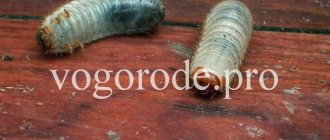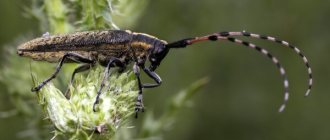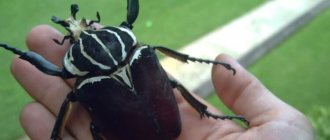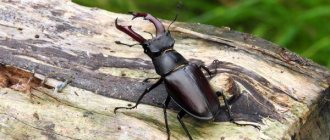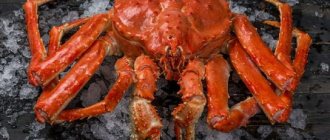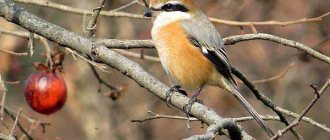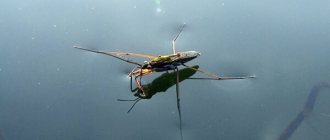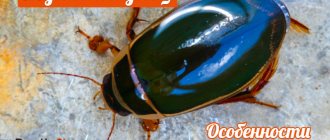Origin of the species
Scientists do not know for certain the origin of Coleoptera. Based on the findings of paleontologists, it can be assumed that their ancestors were cockroaches and protelytropters. Beetles appeared approximately 300 million years ago during the Carboniferous and Permian periods. There is no doubt that the aromorphosis of Coleoptera is inextricably linked with the evolution of large mammals, herbivorous dinosaurs.
Bronzovkas belong to the class of insects, the family of lamellar insects, numbering 4 thousand species, 33 of which live in Russia. The largest representative of the subfamily, which weighs up to 100 g, is the African goliath beetle.
Polymorphism is widespread within the species—the formation of different forms due to the influence of aboriginal living conditions. The common bronzer has 7 subspecies, differing in color tone, integument sculpture, habitat, degree and places of hair growth. The first description of the golden bronze was presented to the scientific community by Carl Linnaeus in 1758.
Folk remedies
The bronze beetle (you already know what the pest eats) flies well. Naturally, in this case it is better not to use chemicals. They will harm the trees. The fact is that in this way you can destroy other insects that provide pollination. In addition, chemicals can accumulate in the fruit. Although in some cases you can use poison for Colorado potato beetles. Moreover, it is better to spray not the plants themselves, but the soil around them.
You can also bury a special drug “Medvetox” under the bushes. It helps kill insects that burrow into the ground at night. You can also kill the larvae very quickly. To do this, add “Thunder” and “Bazudin” to the places where they develop. These drugs are usually sold in granules.
Liquid smoke can be used to repel insects. Just 3 tablespoons per bucket of water is enough. In order for the mixture to stick well to the leaves, you need to add a little soap (can be liquid) or washing powder.
You can also use an infusion of wood ash. To prepare the solution, you need to use 1 glass of raw material, which is diluted in 5 liters of liquid. You need to infuse the ash for at least 5 days. After this, also add liquid soap to the composition.
Description of the Beetle
Cetonia aurata is Latin for metallic and golden beetle. Color is the main distinguishing feature of an insect, but there are two more features.
On the sides of the elytra there are cutouts through which the arthropod releases and raises well-developed wings. In this case, the elytra do not change location. The second feature is scaly spots on the thighs, abdomen, elytra, pronotum, and sides of the thorax.
Chitinous covers consist of several layers. On the rounded head, which passes into the prothorax, sensory organs are located. On the sides there are compound eyes, between them there are antennae that help to touch and smell. The palps on the lower jaw and lip are needed for touch and taste.
The structure of the limbs is determined by the lifestyle. To make it easier for the common bronze to dig the ground, there are teeth on the thickened tibiae of the front legs. The middle and hind legs are equipped with spurs.
What does it look like
The representative of the lamellar family looks like a beetle, measuring 1.3–2.3 cm in length and 0.8–1.1 cm in width. The oblong, rounded, short body shimmers with a changeable metallic tint. The predominant colors are emerald, golden green or bright green.
The large beetle has a head with a longitudinal keel, covered with whitish hairs, and slightly lowered. The widest part of the body is the pronotum. Between it and the elytra in the shape of an isosceles triangle there is a shield. The elytra themselves are marked with strokes and stripes.
Character and lifestyle
Bronzers are active exclusively during the daytime. They prefer sunny, warm weather. When the sun hides behind the clouds, they sit motionless on the plants. If it is damp and cloudy outside, they take cover under fallen leaves on the ground. They spend the night there.
How many months the beetles fly depends on the climatic features of the area. The longer the summer, the longer the activity remains. Despite their heavy weight, bronze birds fly well.
The fact that the fender liners remain pressed to the body reduces take-off time. This circumstance helps to avoid danger when meeting an enemy.
If there is a choice, they descend on a large flower to extract as much nectar as possible and gain strength to move to another plant.
Maneuverable beetles sometimes collide with an object in flight and fall belly up to the ground with a dull sound. They move their short legs for a long time until they manage to roll over. They spend most of their lives searching for food.
What does it eat?
The Golden Bronzefish feeds variedly. The diet after wintering includes tree sap, young leaves, and shoots. During flowering, the beetle drinks nectar, eats pollen, petals of flowers of fruit trees, berry bushes and herbaceous plants.
When the fruits are overripe, insects attack rowan, cherry, blackberry, viburnum, apricot, apple, and pear trees. They eat the seeds of umbrella plants. Vegetable crops are also not ignored. They especially like legumes, cabbage, and cereals.
Flowers they prefer are roses, irises, and peonies. They love to eat lilac flowers. The larvae, while in compost, litter of fallen leaves or rotten wood, eat plant debris.
Where does it live?
In Eurasia, the bronzeback is not found only in deserts. The beetle can be seen in the countries of Scandinavia, Europe, England, Asia Minor, Western and Central Asia. The insect is found not only on the mainland, but also on the islands of the Mediterranean Sea.
In Russia, the beetle's range extends from Lake Ladoga through Yekaterinburg, Novosibirsk to Lake Baikal. The distribution area includes the Amur region, southern Crimea, and the Caucasus.
Suitable biotopes are forest edges, meadows, forest-steppes. Rarely lives in dense forests, preferring open, well-lit areas.
In the mountainous areas of Transcaucasia and Central Asia it lives at an altitude of up to two thousand meters above sea level. In the northern regions it settles on the plains.
Reproduction
Mating and reproduction lasts the entire season, which lasts 2.5–4.5 months. Sensitive antennae help the male find the female secreting pheromones. Their tips are equipped with plates that open in the form of a fan.
A fertilized female lays up to 20 eggs in compost heaps, anthills, rotting leaves or rotten stumps.
Larva
Scientists still have not figured out why ants do not touch alien offspring. According to one hypothesis, it is due to the repulsive smell.
Two weeks later, voracious larvae with powerful jaws appear. They tirelessly pass large volumes of plant debris through themselves, without using the undeveloped small legs. They move on their back, contracting and relaxing the muscles of the rollers.
The larva looks like this:
- cream-colored body 4–6 cm long, bent in an arch;
- the body tapers towards the head;
- each jaw has four teeth;
- legs are small;
- antennae - thick and short;
- two rows of spines surround the anus.
By the time of wintering, due to rapid growth and three periods of maturation, the larvae have time to molt several times. The following year, pupae are formed - the last stage before the formation of the adult.
Doll
Life cycle
The stages of egg, larvae, pupae, and adult go through the stages of the golden bronze in most cases in one year, in the northern regions - in two. From eggs laid in summer, larvae are formed, which intensively feed on organic matter until winter.
When they grow to 6 cm, pupation occurs. The larva makes a strong false cocoon from dust, excrement, soil, and fastens it with its own secretion. Externally, the pupa resembles an adult insect with a head tucked under the chest and short wings.
After two weeks, the pupa turns into an imago, hibernates until spring in a shelter or comes to the surface. With a two-year life cycle, the life expectancy of the imago is from six months to 12 months.
Natural enemies
Bronzewolves are eaten by black-headed shrikes, corvids (especially magpies), and orioles. In winter, tearing apart anthills in search of food, foxes and badgers find larvae.
Don't mind eating bugs:
- moles;
- hedgehogs;
- weasels, ferrets, martens;
- lizards;
- frogs.
Scolia flies, tachina flies, and ticks parasitize the larvae. Wasps are especially dangerous. They paralyze the victim by piercing the nerve responsible for movement with their sting. Then they drag it into a hole and lay eggs on the half-dead carcass. This is how Scolia provides food supplies for its offspring.
Wintering
Male golden bronzes die immediately after mating, females die after laying eggs. Bronze beetles mainly overwinter at the stage of pupae and adult beetles in cocoons in the same places where the female laid her eggs. After warming, already formed individuals come to the surface.
But sometimes the Common Bronzewort in the adult stage emerges from its shelters in the fall. The beetle leads an active lifestyle, and with the onset of cold weather it takes refuge in rotten stumps, tree hollows, forest litter or compost heaps. In spring, such insects are the first to wake up.
Habitat
Bronzewort can be found almost throughout Eurasia; it does not live only in mountainous and desert areas. Depending on the species, the habitat is slightly different. For example, the golden one is distributed from the south of Scandinavia to the Balkans, on the coasts of the Mediterranean Sea, in Asia Minor, and Tajikistan.
The smooth bronzeback is considered an endangered species; it lives in temperate climates, most often settling in old gardens and forests. Bronzovka stinking prefers areas with warm climates.
In the photo the bronze is smelly
The habitat of the bronze is very large, but there are places where it does not live. For example, it does not like desert areas, does not live in the northern part of the Crimean peninsula, in steppe spaces.
In Russia, the northern border of the range runs along the Karelian Isthmus, the eastern border is on Lake Baikal, and from the south the range is limited by the Crimea and the Caucasus. Due to the fact that the bronze beetle is a non-migratory insect, and its larvae must feed on woody vegetation, it is found only in areas with bushes and trees.
Golden can be found in semi-deserts and deserts, but only in river valleys, where there is the growth it needs. Bronzovka prefers open, light areas - forest edges, plots, clearings, meadows. Sometimes they are also found in the forest - they fly deep into the forest for the sake of the sap flowing from the trees, which some species primarily feed on.
Meaning for humans
People's attitude towards golden bronze is ambiguous. The larvae do not harm green plants and increase soil fertility. During the growth process, they release vermicompost thousands of times more than their own weight and the benefits they bring are comparable to earthworms.
Bronze larvae are often confused with beetles, but they have significant differences. The cockchafer larva has longer legs, a more powerful jaw, and a larger head. Bronze is more hairy.
If we talk about adult insects, their harm consists of eating shoots and young leaves, stamens, stigmas, pollen, core and petals of flowers. The damage caused cannot be considered significant. Proof of this is the absence of insecticidal agents aimed at destroying the species.
To please children, some adults keep golden bronzes at home. It is not difficult to create an insectarium suitable for beetles. You will need a cage or a tall aquarium with a volume of at least 10 liters with a lid.
The dwelling is equipped by lining the bottom with a 20-centimeter layer of turf-peat substrate. Sand, fallen leaves, and wood dust are added to it. They decorate with driftwood, stones, and plant unpretentious plants (ficus, wax ivy).
Keeping conditions are room temperature, additional lighting with fluorescent lamps, moistening the substrate and feeding. In summer, lilac flowers, peonies, and roses are added to the winter diet, consisting of slices of fruits, vegetables and honey.
Nutrition
Bronze wrens feed on different foods, depending on the species. But these are always different parts of plants. For example, the stinking bronze beetle feeds on flower pollen, while its larvae eat roots.
The smooth one loves the juice of overripe fruits, and the green one eats the whole flowers. The flowers of wild and cultivated plants and trees are eaten. Bronzeworts feed on leaves and thin bark, and drink tree sap.
Due to the fact that it happily eats flowers and young shoots of such cultivated trees as apple and pear trees, it is considered a pest among gardeners. People fight any pest, and the bronze beetle - to kill the beetle, various preparations are buried in the soil under fruit trees.
Since the bronze fly spends the night in the ground, the poison will affect it, but will not harm beneficial insects, such as bees. In the wild, bronzes most often eat the flowers of knotweed, mountain ash, sorrel, thorns, peas, thistles, sage and many other plants.
In gardens and vegetable gardens, rose hips, apple trees, pears, beets, carrots, mustard, rye, and corn suffer from them. Bronzovka also loves cultivated flowers - lilacs, irises, roses, dahlias and even home orchids. Beetles suck out plant sap and eat stamens and pistils. On young shoots they like to eat the bark and edges of leaves.
Golden bronze in the Red Book
The beetle Cetonia aurata was listed in the Red Book of the Moscow Region in 2001 and remains there to this day despite its increasing numbers in some years. The golden bronze was assigned category 3, “vulnerable species in Moscow.”
Unfavorable factors:
- reducing the area of biotopes for adult insects due to development and mowing of meadows;
- removal of leaf litter and old dead trees in park areas;
- catching by children because of their decorative appearance.
Measures to increase the number of the species are aimed at limiting sanitary clearings, preserving meadows with flowering plants, and leaf litter in forests outside recreation areas for city residents.
Harm from larvae
After fertilization, the female lays one egg at a time (rarely 2-3) in the soil or old tree stumps. The bronze larva appears after 2-3 weeks. For 2 months they feed on dead roots or other plant debris, which at that time are decomposing in the soil.
At this stage of development, the pest is not dangerous, but even useful. The larva constantly eats, crushing plant debris that is already partially destroyed by putrefactive processes. In this way, it accelerates the decomposition of solid particles, which would remain intact for a long time.
Interesting facts about insects
Amazing facts about the common bronzeweed:
- beetles fly from place to place, so chemicals cannot exterminate them;
- The bronco is distinguished from the green pied by the Latin letter V on the metanotum;
- the bright emerald color with a metallic tint is formed due to the ability of the integument to scatter light;
- brightness and shine not only attract individuals of the opposite sex, but also protects them from enemies, concealing the outlines of the body;
- the frightened bronze, in self-defense, releases a sharp-smelling liquid.
The formation of the floor is influenced by the ambient temperature. In hot weather, more females emerge from the cocoons; in cool weather, more males emerge. Among bronze beetles, genetic changes are common, in which beetles of mixed sexes appear with male and female characteristics on two halves of the body.
How to fix the problem naturally?
In order to deal with a pest, you need to use several methods to eliminate it.
If the number of beetles is small, then they can be collected manually. This method is considered as safe as possible for plants and the environment. Collecting insects is not difficult. They are clearly visible on the leaves due to their golden tint. It is enough to simply shake off the individuals sitting on the bushes into a bag. Then you can destroy them simply by crushing them with something heavy. If the beetles are high on the tree and cannot be removed manually, then you can simply lay out a film under the crown and shake the crown a couple of times. Simply collect fallen insects and drown them in water or crush them.
Light traps that are used only at night are also very effective. Making them is quite simple. An ordinary lamp is installed in an ordinary glass jar. Since insects usually fly towards the light, they hit the walls of the jar. Near it you need to place containers with kerosene. After the insect loses its orientation, it falls into this vessel and dies in it.
In addition, there are some species of birds that feed on these pests. Try to attract magpies, rooks or jackdaws to your garden. They will quickly deal with these insects.
Circulatory system
Like other arthropods, this insect has an open circulatory system. With the flow of blood in the body cavity, internal organs and tissues receive nutrients. The movement of blood is provided by the heart, which pulsates and drives it to the head end of the body. Its reverse flow is impossible due to the heart valves. When the heart expands, blood enters it from the back of the body. The side openings of the central organ of the circulatory system have valves that prevent the reverse flow of blood. This biological fluid does not participate in the respiratory process.
Internal structure
Respiratory system
It is made up of many tubes with branches (tracheas). They deliver air entering the body through the spiracles to other systems.
Digestive system
The upper jaws bite off parts of the leaves, and the lower jaws grind them. The food then passes into the esophagus and from there into the stomach . It is equipped with teeth made of chitin to grind food. The remainder of the digestion process occurs in the intestines , and processed food is excreted through the anus.
Excretory system
A bunch of tubes closed at the top, the bases extend into the intestines. Their task is to filter metabolic products and convert them into crystalline substances.
Circulatory system
Blood does not take part in respiration; it only carries nutrients to the organs, carrying excretory products away from them. Moves due to the functioning of the heart.
Nervous system
Primitive, contains a peripharyngeal ring and an abdominal chain. The brain is a collection of nerve cells fused together.
Reproductive system
How does the cockchafer reproduce? The female has a pair of ovaries , which connect to form an oviduct. It brings the eggs formed in the ovaries out after maturation. To receive the seed there is a special reservoir - seminal receptacle .
The male has testes , they pass into the vas deferens and connect into a single canal for ejaculation.
insect eggs
What do cockchafer eggs look like? May beetle egg - photo:
Compared to the eggs of other insects, they are quite large - their length is 3 mm, width 2 mm. The color is dirty white, the shape is oval, widened on the sides.
The egg goes through a development cycle of about 30 days . The presence of unfavorable conditions extends it to 45-50 days. Eggs tend to gradually harden , beginning development under soft covers.
How to protect the outside of your home with Clipper insecticide
Very good results are obtained if the new generation preparation Clipper is used for processing wooden structures. But it is effective to use only for protecting the external walls of the house; it is not suitable for indoor treatment.
The chemical insecticide Clipper (produced by ZAO FMRus) destroys and repels longhorned beetles, and also affects their reproductive system and inhibits the development of laid eggs. The drug has a contact and intestinal effect on beetles and their larvae.
Once in the body of the larva, the drug causes disruption of metabolic processes and paralysis, leading to the death of the pest. A beetle, sitting on the treated surface and coming into contact with the preparation, will die without laying a new egg.
The drug is recommended for use on lumber and the external surface of a wooden house. Treatment of dry wood should be done with a solution prepared strictly in accordance with the instructions, in dry cloudy weather, avoiding direct sunlight.
Its economical use, high efficiency and fairly low toxicity have been proven. However, it is a pesticide and its use requires compliance with special safety rules. Therefore, it is better to entrust the processing to specialists.
XILIX® Gel fungicide and insecticide in one bottle with a 10-year guarantee!
XILIX® Gel is an innovative development for combating any wood pests such as longhorned beetles, borers, shashel, wood borers, etc. It is also an effective professional biocide that effectively destroys mold, mildew, and copes with wood rot and defects.
Indispensable for the prevention and treatment of wooden structures.
• Destroys termites, borer beetles, bark beetles, wood borers, longhorned beetles, etc. • Economical and easy to use • Safe for people • Strengthens the structure of the wood • Ready to use, the gel does not flow, leaves no traces • Penetrates deeply into the wood
XILIX® Gel is an excellent, safe alternative to phosphine gas fumigation with a 10 YEAR warranty! High efficiency is achieved thanks to properly selected gel components. Biocides and permethrin in the composition give a fantastic insecticidal and fungicidal effect.
Thanks to its thixotropic formulation, the gel works without loss of properties even in a thick layer of wood, thereby reducing the number of applications to obtain the required therapeutic or prophylactic dose of the gel.
What does it eat?
What do cockchafers eat? The larvae eat various roots , and the adults eat foliage .
Is the cockchafer a predator or not? Despite its impressive size, exceeding most other insects, the cockchafer poses no danger to them at all, eating exclusively plant foods .
May beetle pupa - photo:
